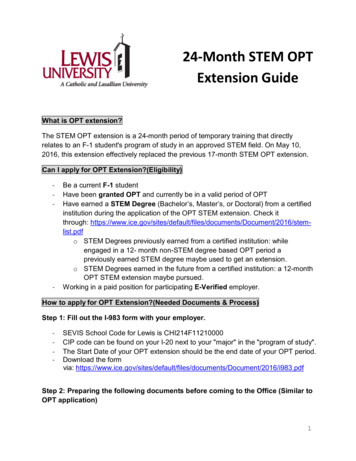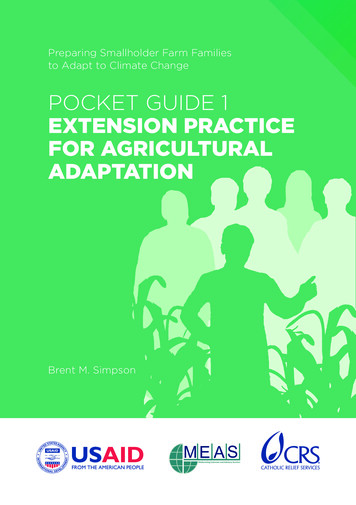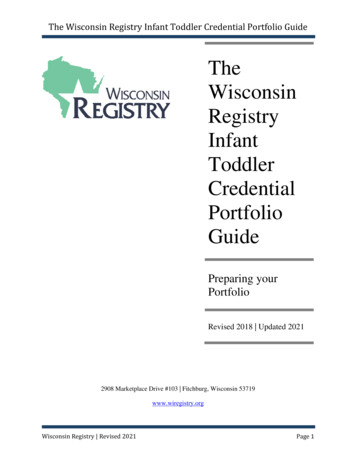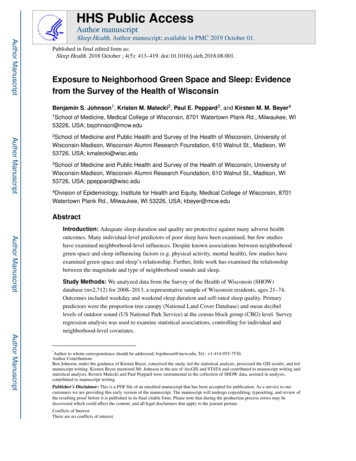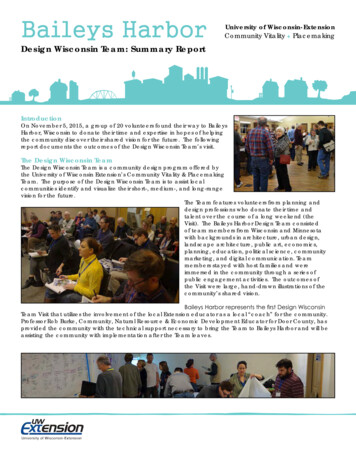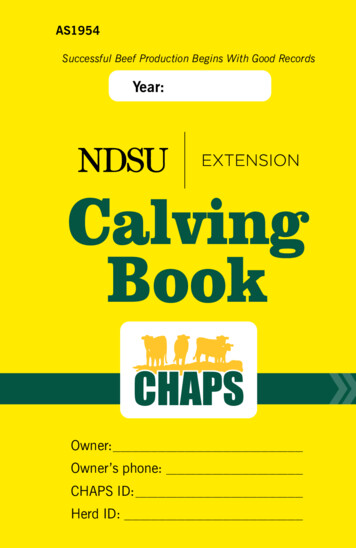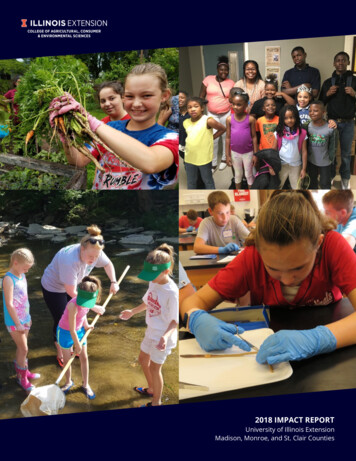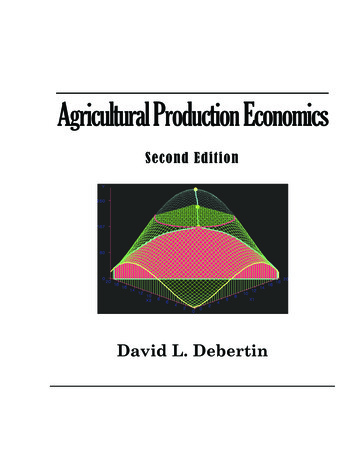
Transcription
UNIVERSITY OF WISCONSIN - EXTENSIONCentral Wisconsin AgriculturalExtension Report January 2018CONTACT INFORMATIONFOR 7-COUNTYTEAM MEMBERSAdams County: VacantAgronomy & Nutrient Management569 N. Cedar, Suite 3Adams, WI 53910(608) 339-4237lynn.dolata@ces.uwex.eduPortage County: Ken SchroederVegetable Production1462 Strongs AvenueStevens Point, WI 54481(715) 346-1316ken.schroeder@ces.uwex.eduJuneau County: Alana VossDairy & Forage Management211 Hickory St.Mauston, WI 53948-1386(608) 847-9329alana.voss@ces.uwex.eduWood County: Matt LippertDairy & Cranberry ProductionCourthouse, 400 Market St.PO Box 8095Wisconsin Rapids, WI 54495-8095(715) 421-8440matthew.lippert@ces.uwex.eduWaushara County: Ken WilliamsFarm Business ManagementCourthouse, 209 S. St. Marie, PO Box 487Wautoma, WI 54982-0487(920) 787-0416ken.williams@ces.uwex.eduGreen Lake County: VacantAgronomy, Commercial Horticulture & Marketing571 County Road A, PO Box 3188Green Lake, WI 54941-3188(920) 294-4032kathleen.ninneman@ces.uwex.eduMarquette County: Lyssa SeefeldtLivestock Production & Emerging Markets480 Underwood Avenue, PO Box 338Montello, WI 53949(608) 297-3141lyssa.seefeldt@ces.uwex.eduIndustrial Hemp in Wisconsin:The First Steps!Ken Williams—Agriculture Agent, Waushara CountyThe University of Wisconsin Madison and UW Extension have been inundated with questions related to industrial hemp production since the passing of the 2017 Wisconsin Act 100. The belowinformation was authored by Patrick Robinson, Associate Dean Department of Agriculture andNatural Resources, Cooperative Extension, University of Wisconsin Extension. Patrick recognizesWilliam (Bill) Barker Associate Dean for Research, The College of Agricultural and Life Sciences,The University of Wisconsin - Madison as a significant contributor to this article. Patrick also recognizes The Department of Agriculture Trade and Consumer Protection (DATCP) and the NationalInstitute of Food and Agriculture (NIFA) sources as some language was copied verbatim for legalpurposes. Wisconsin growers will be able to grow and process industrial hemp under 2017 WisconsinAct 100, a law recently passed by the Legislature and signed by the Governor. The law directs the Wisconsin Department of Agriculture, Trade and Consumer Protection to write anemergency administrative rule that will spell out the details of the program, including requirements for growers. This is a pilot program to study growth, cultivation and marketing ofindustrial hemp. Participants will be required to obtain a license from DATCP to growhemp, and to pass a background check before receiving a license. DATCP will complete the emergency rule by March 2, 2018. This rule will remain in effect until July 2020, oruntil the permanent administrative rule is completed – whichever comes earlier. As of today, the rules and pilot program have not been developed. More can be found here:https://datcp.wi.gov/Pages/Programs Services/IndustrialHemp.aspx. USDA NIFA is authorized to support industrial hemp research where such activity complieswith state law. Further, the researcher must either 1) be an institution of higher education or state department of agriculture, 2) or grow the industrial hemp under the auspices of a state agricultural pilot program. More can be found here: https://nifa.usda.gov/industrial-hemp. Section 7606 of the 2014 Farm Bill did not alter the approval process for new drug applications or any other authorities of the FDA, nor does it alter the requirements of the ControlledSubstances Act that apply to the manufacture, distribution, and dispensing of drug productscontaining controlled substances. Whether hemp may be grown for food and pharmaceuticalproducts remains a question for the FDA and/or the DEA. State agricultural pilot programs must provide for State registration and certification of sitesused for growing or cultivating industrial hemp. Importing seeds into Wisconsin to begin the hemp program may require permission from theU.S. Drug Enforcement Agency, which could affect the time when production can begin.Farmers will need to be patient as this is a very new and dynamic area for both Wisconsin farmersand the legal system.University of Wisconsin, State Department of Agriculture and Wisconsin counties cooperating.An EEO/AA employer, University of Wisconsin-Extension provides equal opportunities in employmentand programming, including Title IX and American with Disabilities (ADA) requirements.
PAGE 2Since 1991, AgrAbility of Wisconsin has been promoting success in agriculture for farmers and their familiesliving with a farm injury, disability or limitation. AgrAbility of Wisconsin is a partnership between the University of Wisconsin Extension and Easter Seals Wisconsin.AgrAbility of Wisconsin has created a significant impact on Wisconsin agriculture by providing assistancein over 6,000 cases to farmers and farm families whohave been able to continue farming or return to thefarm work site through AAW intervention. A strongpartnership between Easter Seals Wisconsin and theUniversity of Wisconsin- Extension has been key tomaking Wisconsin’s project one of the most successfulof its kind in the country.What does AgrAbility do?The vision of AgrAbility is to enable a high qualitylifestyle for farmers, ranchers, and other agriculturalworkers with disabilities. Through education and assistance, AgrAbility helps to eliminate (or at leastminimize) obstacles that block success in production agriculture or agriculture-related occupations.CEN TR AL WISC ONSIN AG RICU LTUR AL EXTENSION REPORTAgrAbilityserves WI farmersAgrAbility serves those agricultural workers who arelimited by any type of physical, cognitive, or illnessrelated disability, such as: amputation arthritis back impairment deafness/hearing impairment developmental disabilities, such as cerebralpalsy or autism disabling diseases, such as cancer or heartdisease mental/behavioral health problems respiratory diseases spinal cord injuries stroke traumatic brain injury visual impairment
CENTR AL WISCONS IN AG R IC ULTU R AL EX TENSION REPOR TPAGE 3
PAGE 4CEN TR AL WISC ONSIN AG RICU LTUR AL EXTENSION REPORTSelecting the right Cover Crops for your FarmAlana Voss—Agriculture Agent, Juneau CountyAs you look into the different cover crops that are available, it is difficult to determine which cover crop species orcover crop mixes will work best for your farm’s needs.Deciding what your goal for the cover crop is will help indeciding your best option to plant. Examples of covercrop species that can help achieve different goals include: Grass Species Help control erosion and increase organic matterin the soil due the large root systems Brassicas Due to fall growth can assist with erosion controllate in the season Can be used as a forage Brings diversity to the plant varieties being planted and the microbes in the soil Legumes Commonly used as a cover crop or in a mix forincreasing the nitrogen available Helps decrease the amount of fertilizer nitrogenneededCrop rotation, equipment needs, herbicide and manureapplications are all factors to be considered prior to deciding the best cover crop for you and your farm. Evaluate all factors that can play affect into growing covercrops before selecting the option that is best for you. Toevaluate your situation, some questions to ask your selfare: What crop will you be planting prior to the covercrops? How will you plant the cover crop? What herbicides from the previous two years will thecover crops be getting planted into? How will you terminate the cover crop? When are you applying manure? Spring and/or fall?After looking at all the factors that can affect your decision, it will be easier to determine the best fit. Also, talking with individuals who have previously tried cover cropswill benefit you to learn from their experiences. Likewise,the best option for you is to start small with only a fewacres and build upon your own personal experiences atgrowing cover crops and what works best for your farm.Let’s take a look at a brief summary of some of the bestoptions for the traditional crops grown in Wisconsin. Thisoverview is for cover crops to follow crops such as wheat,corn silage, soybeans, and grain corn. Since the CWASterritory is in the southern half of Wisconsin according tothe map provided, we will discuss the suggestions forcover crops in southern Wisconsin. You can find more onthe northern half of Wisconsin cover crops on the UW-Extension CoverCrops Website by following this link: https://fyi.uwex.edu/covercrop/.WheatThis early harvestedcrop makes for a greatoption to have covercrops planted after theharvest season. Normally, the cover cropoptions to plant varydepending on the location you are at in Wisconsin, but due to theearly harvest allows formany of the options tobe comparablethroughout the state. One concern can be dealing withvolunteer plants after harvesting. It might be a good ideato allow the volunteer plants to grow enough to use a non-selective herbicide before planting, but timing can makeit difficult if harvesting after July.Small Grains and Grasses Oats and Spring Barley Both will grow in late summer and continue until theground freezes They create a lot of residue to help in limiting theamount of erosion in the spring Oats and Spring Barley can also be used as a forage in the fall, but by doing so will take away theability to control erosion in the spring Annual Rye Grass Has become popular and affordable option, but isnot encouraged due to the difficulties to control itas a weed It is able to overwinter in Wisconsin, but can makeit difficult to use herbicides on due to that ability Creates a lot of seeds the next year and there hasbeen multiple glyphosate resistant types found Winter Rye and Winter Triticale Can be planted in September and August for latesummer and over-winter coverage Rye can create a thick cover in fall and growsquickly in the beginning of spring If used as cover crops need to be eradicated bylate April before the plant becomes too large tocontrol Can be harvested in the spring as a forageBrassicas Radish
CENTR AL WISCONS IN AG R IC ULTU R AL EX TENSION REPOR T Fast growing, can produce large taproot that cango several feet down in the ground if planted in Julyor August Help relieve compaction in the soil through theroots making its way through the many compactedlayers However, research suggests growth of the radishcan be restricted due to compaction and often isnot able to break up compaction Other options Turnips and Rapeseed are comparable to the radish with the tap-rooting, but has less root volume Turnips will winter kill, but Rapeseed should survivewinter and need to chemically removed in thespring They do not leave a lot of residue due to rapid decomposition and due to this will not offer a lot ofhelp with erosion control Brassicas do offer a lot of diversity into crop rotation and microbes in the soilLegumes Can benefit from clover by harvesting as a forageand all options are good for wheat, corn, and soybean grain crop rotation Usually planted in a mixture with grasses and/orbrassicas to create more residue cover to help reduce spring erosion Berseem Clover- fast growing clover and will winterkill, does not do well during dry conditions Crimson Clover- winter kills, but might survive inwarm winter, pH sensitive and can tolerate dry periods, if survives winter grows very quickly in spring Field Peas- cool season annual that is large seeded,best if used with spring cereal grain to promote climbing and reduce lodging Medium Red Clover- perennial that is short lived andis best planted with spring cereal grains or frost seeding in March to April into the fall established cerealgrains Mixes have had limited research, but some statements that hold merit is that they can add more organic material and nutrients to the soil, can improvesoil structure and compaction due to the root structures of cereal grains and grasses, multiple speciesMAY improve the biological and physical benefits tothe soil. Suggested mixes with radishes: Radish at 5 to 8 lbs. per-acre 30 lbs. per-acreoats or spring barley Radish, 5 to 8 lbs. per-acre 35 lbs. field peas 30 lbs. per-acre oats or spring barley Radish, 5 lbs. per-acre 8 lbs. berseem clover 10 lbs. annual ryegrassCorn SilageDue to the extreme loss of residue after corn silage it isextremely important to consider using cover crops following this crop to protect your soil from harsh winter andPAGE 5spring conditions.Small Grains and Grasses Spring Barley and Oats Can be planted in mid-September and will winterkill Can also be planted during the growing season ofthe silage Cereal Rye and Triticale Can be planted all the way into October and cansurvive winter and need to be terminated in thespring Rye Is more winter hardy than triticale and can be planted very late, but lacks the nutrition that triticale hasto offer as a forage for spring cut for dairy operationsBrassicas Due to lack of growing days after the corn silage harvest it is not recommended to plant following cornsilageLegumes Due to lack of growing season for the legumes tocreate nodules and fix nitrogen it is not recommended to grow after corn silageSoybeans and Corn GrainSmall Grains and Grasses Cereal Rye and Triticale Both can be planted well into October and both willnot winter kill, but rye will do better with a laterplanting date than the triticale Both will need to be terminated in the spring, but ifharvesting in the spring as a forage Triticale is preferred Annual Ryegrass, Oats, and barley are not suggested to be planted after soybeans due to the lack ofgrowing days after harvesting soybeans and graincorn to create enough residue to make an impact andall will winter kill However, if planted during the soybean growingseason they may be able to create enough residueto make an impact for winter and spring erosionBrassicas Due to lack of time for cover crop to become established and grow it is not suggested to plant brassicasafter soybeans and corn grain.Legumes Due to lack of growing season for legumes to formnodules and fix nitrogen it is not recommended toplant legumes after soybeans and corn grainYou can learn more about cover crops by checking outthe UW-Extension Cover Crops Website by following thislink https://fyi.uwex.edu/covercrop/conference/. Also,there is a Cover Crops Conference this winter in StevensPoint, WI on February 27, 2018. You can learn more byseeing the ad in this newsletter on this upcoming event orfollow this link to learn more: https://fyi.uwex.edu/covercrop/conference/.
PAGE 6CEN TR AL WISC ONSIN AG RICU LTUR AL EXTENSION REPORTThank you to our sponsors
CENTR AL WISCONS IN AG R IC ULTU R AL EX TENSION REPOR TPAGE 7
PAGE 8CEN TR AL WISC ONSIN AG RICU LTUR AL EXTENSION REPORT2018 Private Pesticide Applicator TrainingClasses OfferedKen Schroeder—Agriculture Agent, Portage CountyPrivate Pesticide Applicator Training classes willonce again be offered by your local UW-Extensionoffice. Anyone who intends to purchase, mix, load,apply, or direct the use of restricted use pesticidesas a private applicator must be certified. Certification is good for five years. There are two ways tobecome certified. Purchase and study the trainingmanual and attend an all-day training class offeredby your local UW-Extension office. These classesconsist of presentations followed by a written examJanuary 5January 9January 16February 9February 9February 15February 16February 21-Green Lake CountyWaushara CountyAdams CountyPortage CountyJuneau CountyMarquette CountyWood County (Marshfield)Marathon County (Wausau)at the end of the day. If you are unable to attendone of the classroom sessions, the second option isto self-study and schedule time through the UWExtension office to take the exam on your own.Training manuals are available at your local UWExtension office and must be purchased prior to exam day.Please register at least one week prior to theexam date at the Extension office where you willbe taking the exam.February 22March 1March 2March 2March 7March 9March 16March 23-Marathon County (Stratford)Waupaca County (Waupaca)Portage CountyClark County (Neillsville)Clark County (Colby)Clark County (Thorp)Portage CountyAdams CountySave the date!Heart of theFarmComing toMarquetteCountyNew this year for MarquetteCounty will be a Heart of theFarm program for farm women.The Heart of the Farm programwill be March 16 at the NeshkoroArea Community Center. Moredetails to come. If you are interested in knowing more aboutthis program and to get on themailing list for when registrationdetails are available, please contact Lyssa Seefeldt at 608-2973141.
CENTR AL WISCONS IN AG R IC ULTU R AL EX TENSION REPOR TPAGE 9Wisconsin Dairy & Beef Well-Being ConferenceLyssa Seefeldt—Agriculture Agent, Marquette CountyThe annual Wisconsin Dairy and Beef Well-BeingConference will be held March 21, 2018 at the Tundra Lodge in Green Bay, WI. New to the conferencethis year is a pre-conference on March 20 gearedtoward dairy workers. The pre-conference will focuson dairy worker skills and will be simultaneouslypresented in Spanish. Topics that will be coveredinclude pain management of dehorning, managinglameness, animal handling as it relates to carcassquality, and more. Topics for the conference and pre-conference will be posted as they are available onthe conference website. Regular conference pricingis available by registering prior to March 9. Cost is 50 for one day registration or 80 for veterinarians.Two day registration is 75 or 105 for veterinarians. A 20 late fee applies for any registrations re-ceived afterMarch 9. Continuing education credits areavailable forveterinarians,veterinary technicians, humane officers, and ARPAS members. For farmerswith a Beef Quality Assurance Certification, you willbe eligible for one continuing education credit tomaintain your BQA certified status. Registration details will be available at http://fyi.uwex.edu/animalhusbandryconference/ by late January 2018.For questions on this conference, contact LyssaSeefeldt at 608-297-3141.Harsdorf Encourages Farmers to Complete Ag CensusNews Release—Wisconsin Department of Agriculture, Trade & Consumer ProtectionEDITORS NOTE: A video message from Secretary Harsdorf is available online at https://youtu.be/TI-x5OQgDbc.MADISON – Tis’ the season when mailboxes and frontporches are overflowing with holiday cards and wrappedpackages. Through all the hustle and bustle, farmersshould also look for their 2017 Census of Agriculture form,set to arrive in the mail this December. Wisconsin Department of Agriculture, Trade and Consumer Protection(DATCP) Secretary Sheila Harsdorf encourages farmersto complete and return their Census this winter.“I know how busy you are with fall harvest and farmchores, but I promise you that filling in your Census istime well-spent,” said Harsdorf. “As a legislator, I saw howvaluable census data was when making policy decisions. Iknow as Secretary, we here at DATCP will use the census information often when working with government officials, agribusinesses and industry partners.”The Census of Agriculture is a complete count, taken every five years, of America’s farms, ranches and the peoplewho operate them. About 84% of Wisconsin farmers completed the 2012 Census of Agriculture, which was one ofthe highest response rates in the country. WisconsinState Statistician Greg Bussler hopes that we can exceedthat number this year.“The Census of Agriculture is the only source of uniform,comprehensive and impartial agricultural data for everycounty in the nation,” explained Bussler. “The more farmers who complete the census, the more accurate the in-formation we’ll have available for decision makers to relyon.”Data on land use and ownership, operator characteristics, production practices, expenditures and more is captured. Information provided in the Census of Agriculturewill be kept confidential, and results will be available inaggregate form only.Farms of all sizes, whether in rural or urban areas, shouldbe counted. A farm is any place from which at least 1,000 of agricultural products were produced and sold,or normally would have been sold, during 2017.“The Census is each farmer’s opportunity to report howbig of an impact agriculture really has on our local communities, state and country,” added Harsdorf. “This is thechance for farmers to share their story and influence future budgets, services, programs and policies. Thank youfor taking time to complete the Census.”New this year, farmers can complete the Census onlineor via the mail. The online form is accessible on any electronic device, calculates totals automatically and skipsquestions that do not pertain to your operation. Visitwww.agcensus.usda.gov for more information.The deadline for farmers to complete the census is February 5, 2018. Census data will be available in February2019.For more information, call the National Agricultural Statistics Service at (888) 424-7828.
PAGE 10CEN TR AL WISC ONSIN AG RICU LTUR AL EXTENSION REPORTPork Quality Assurance (PQA) Plus and TransportQuality Assurance (TQA) TrainingLyssa Seefeldt—Agriculture Agent, Marquette CountyPork Quality Assurance and Transport Quality Assurance training is a good marketing tool that canshow consumers that you care about doing things ina responsible manner while delivering a high qualityend product. The training can help guide you withbest management practices to ensure a safe workenvironment while maintaining animal well-being.Transport Quality Assurance focuses on helpingswine transporters, producers and handlers understand how to handle, move and transport pigs andthe potential impacts of those actions on pig wellbeing and/or pork quality. The TQA training also covers rules and regulations that handlers and transporters need to be aware of.Area swine producers and their employees will havean opportunity to become PQA and TQA certified: January 17, 2018 starting at 9 am at the Mar-quette County UW-Extension office in Montello March 23, 2018 starting at 9 am at the Por-tage County UW-Extension office in StevensPointOther training dates and locations are available perrequest for individuals with expiring PQA Plus certifications. More training dates will be availablethroughout the year. Please note that a Spanish version of the training is also available.This training is an opportunity to certify in the program, or renew your certification(s). The PQA training session will focus on the 10 Good ProductionPractices, which are common sense practicesbased on sound scientific principles. The PQA training will take approximately 3 hours. Individuals mustpass an open-book exam, missing three questionsor less. Certification is good for three years from thetraining date.For TQA training, the session will last about 2 hours.You must pass a 50 question, open-book exam.Successful completion of the training results in certification that is good for three years from the date ofyour training.To register for this session, please call the Marquette County UW-Extension office at 608-297-3141with your name, phone number, which location, andhow many areattending byJanuary 12 orMarch 19 respectively. Please include the names of any additional people attending. Please contact the Marquette County UW-Extension office to register forthe Spanish version to ensure that the Spanish materials are available for the training. If you need anaccommodation to fully participate in this program,please contact Marquette County UW-Extension at608-297-3141 or WI Relay 711. Please allow ussufficient time to arrange the accommodation.Does January 17 or March 23 not work for yourschedule to re-certify? An online option is availableto you. Contact the Marquette County UWExtension office to enroll in this option. Other training days and locations can be arranged to get producers certified as needed. Please contact LyssaSeefeldt at 608-297-3141 to discuss additional training days and location.UW-Extension CropResearch Updatesfrom State SpecialistsDo you want to know the latest and greatest research comingout from the UW-System? Check out the links below for themost current research on field crops and variety performance.2018 Pest Management in Wisconsin Field Crops:https://goo.gl/X5FYc9 (Note: lengthy file at 270 pages)2017 Forage Variety Update for Wisconsin (A1525):https://goo.gl/hvPzzF2017 Corn Hybrid Performance Trials (A3653):https://goo.gl/5TMDnn2017 Oats & Barley Performance Tests (A3874):https://goo.gl/au21692017 Winter Wheat Performance Trials (A3868):https://goo.gl/dwDBHr2016 Soybean Variety Performance Trials (A3654):https://goo.gl/x646Hp2017 Commercial Vegetable Production in WI (A3422):https://goo.gl/UtZDHD (Note: lengthy file at 318 pages);the 2018 version will be available late January 2018.
CENTR AL WISCONS IN AG R IC ULTU R AL EX TENSION REPOR TP AGE 11Brochure available at https://goo.gl/tDx8JCDriftless Beef ConferenceThe annual Driftless Beef Conference will be heldJanuary 25-26, 2018 in Dubuque, IA. More information is available at http://www.aep.iastate.edu/beef/.Pork/Corn/Soy ExpoThe Wisconsin Pork Expo is held in conjunction withthe Corn/Soy Expo every year. Once again, theexpo will be held in Wisconsin Dells on February 12, 2018. The UW-Extension swine team will be present and there will be an opportunity to get PQAPlus certified as well as Transport Quality Assurance certified. Expo details are available at http://www.wppa.org/expo/. The training is free of cost,and you do not need to register for the Expo to attend the training. Please RSVP to the WisconsinPork Association at 608-723-7551 if you plan onattending the PQA or TQA training so there can beenough training materials on-hand.GrassWorks GrazingConferenceThe annual 2018 GrassWorks Grazing Conference will be held January 30-February 1 at the ChulaVista Resort in Wisconsin Dells. Grassworks.org hasmore information and registration details. To view theconference brochure, visit https://goo.gl/mZzmkb (thisis a direct link to the GrassWorks Conference Brochure).WI Garden ExpoThe Wisconsin Garden Expo will be held February 911, 2018 at the Alliant Energy Center in Madison.More details can be found at http://www.wigardenexpo.com/.Cattle Feeder MeetingLyssa Seefeldt—Agriculture Agent, Marquette CountyOnce again, the central Wisconsin area will be hosting a cattle feedermeeting. This year we will be in Stevens Point at the Extension office,time to be determined yet, but save the date of February 28, 2018.Topics to include: corn starch and feedlot cattle performance, transportation quality assurance opportunities, market outlook, and beefdecision making tools. A registration form with more details will bemailed to farmers on the Marquette County beef mailing list. If you are unsure of whether you are on the mailing list, contact the Marquette County UW-Extension office at 608-297-3141.Visit theCentral Wisconsin Agricultural Specialization Teamon the web http://fyi.uwex.edu/cwas/
PAGE 12CEN TR AL WISC ONSIN AG RICU LTUR AL EXTENSION REPORTHoof HealthMatt Lippert—Agriculture Agent, Wood CountyAs I write this we have had a real old fashioned startto the winter. Sometimes we think of lameness asbeing a problem associated with summer or fall ascows sometimes experience lameness as a followup to heat stress. However cows not getting the exercise they need in a tie stall barn due to coldweather can also contribute to lameness. In freestalls in cold weather cows may avoid certain stallsor even entire rows of stalls because of frozen,lumpy hard surfaces. During extreme cold weather itis not unusual to find that cows are standing significantly more than is desirable. Cows in many different environments are at risk of becoming lame.Concrete can be a problem but also in grazing systems where cows need to walk from field to milkingcenter cows are at risk of becoming lame. Lameness is a condition that can vary in severity. Counting all degrees of lameness studies in several countries have typically shown 20% of cattle showingsome degree of lameness on average.Lameness can be influenced by nutrition, genetics,environment, contagious pathogens, hoof care programs and age. During cold weather make effort tokeep stalls even and useable, use sand or shavingsto make frozen walking surfaces less slick, if cowswalk to the parlor try to minimize time that cows areaway from their stalls. Cows should be able to liedown 12 to 14 hours per day. It may appear thatcow’s schedulesare not very rigidbut it takes time toeat and drink, tobe milked etc. In the end cows scheduled do need tobe watched to make sure they have time to do important things such as lying down. Too much time inthe parlor, too much time in headlocks for herd examinations, crowding causing competition for stallspace or cows standing avoiding uncomfortablestalls can all rob cows of important lying time.There are a couple of publications at the UW I encourage you to look at regarding lameness: https://fyi.uwex.edu/dairy/1765-2/. Here you will find HoofHealth and Nutrition and the rest of the “WalkingStrong” Series of Extension Publications.Also I recommend a web browser search for “TheEffect of Housing Type on Lameness Prevalence inWisconsin ” a poster by Nigel Cook of the UW VetSchool.We know that the soundness of a cow’s feet andlegs are an important basis for her profitability andoverall health. We also know there are big differences among herds in the prevalence of lamenessand that it is an area we need to continue to work onto do better.SNAP-Plus Training: February 27, 2018Green Lake County UW-Extension & Land ConservationSNAP-Plus is computer software designed for Wisconsin farmers to prepare their Nutrient Management plan. You will have a chance to work on yournutrient management plan using SNAP-Plus. It is anexcellent tool f
USDA NIFA is authorized to support industrial hemp research where such activity complies with state law. Further, the researcher must either 1) be an institution of higher educa-tion or state department of agriculture, 2) or grow the industrial hemp under the aus-pices of a state agricultural pilot program. More can be found here: https://
